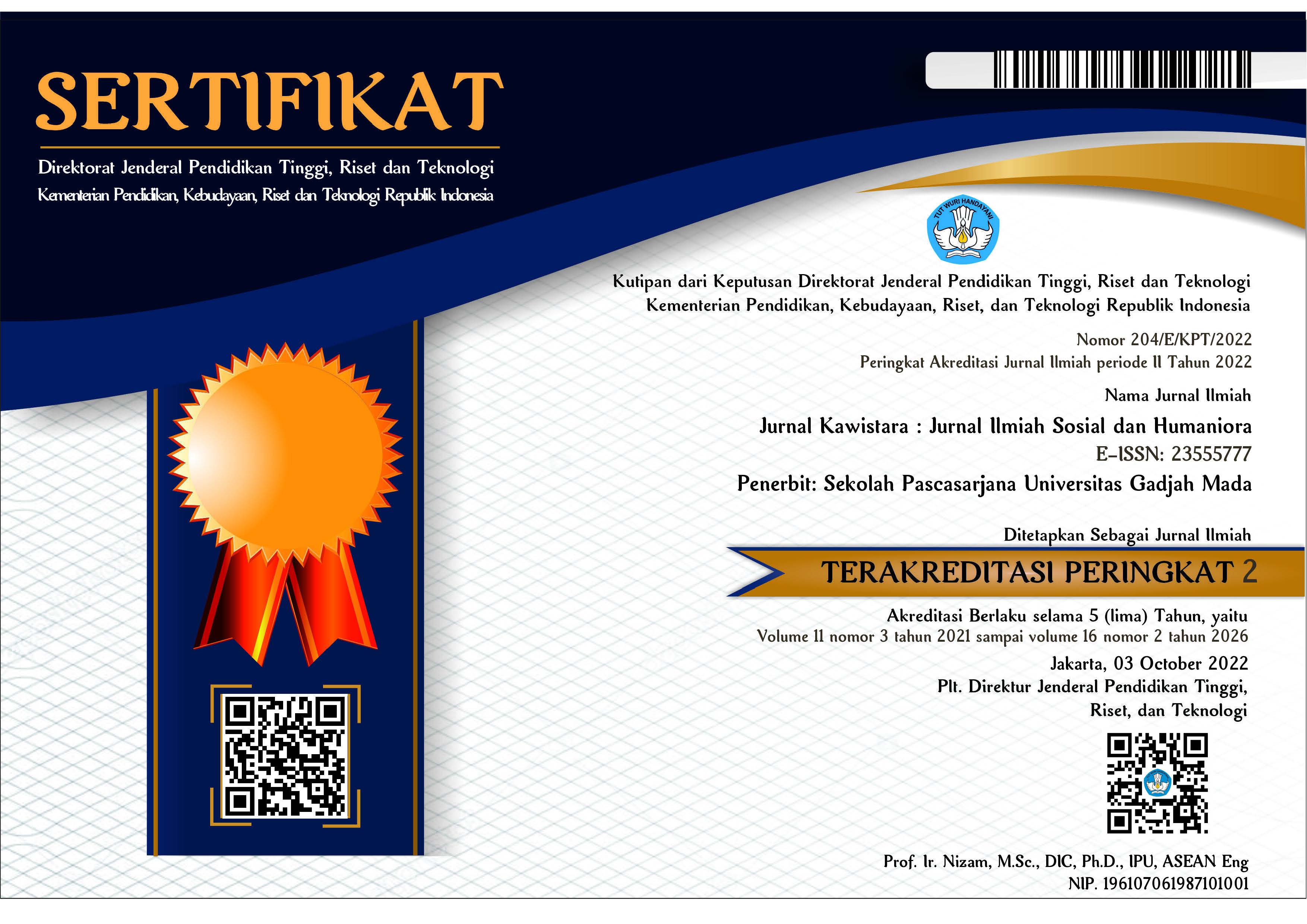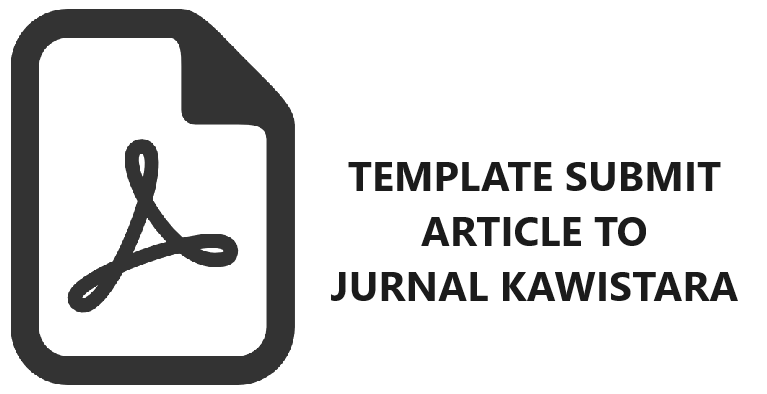Narrative of Religion: The Experiences of Muslim Worship on the Umrah Pilgrimage
Henky Fernando(1*), Yuniar Galuh Larasati(2), Saifuddin Zuhri Qudsy(3), Try Riduwan Santoso(4)
(1) Universitas Gadjah Mada
(2) Universitas Gadjah Mada
(3) Universitas Islam Negeri Sunan Kalijaga
(4) Institut Agama Islam Latifah Mubarokiyah Suryalaya, Tasikmalaya
(*) Corresponding Author
Abstract
Narratives of Muslim experiences have simultaneously influenced the knowledge and meaning
on the umrah pilgrimage to become increasingly complex and contextual. The narrative of the experiences of Muslim worship on the umrah pilgrimage has not been given much scientific attention in previous studies. This study focuses on the question “What is the narrative of the experience of Muslim worship on the umrah pilgrimage?” To answer this question, this study uses a qualitative descriptive approach in exploring the knowledge, meaning, and experiences of Muslim worship on the umrah pilgrimage which is disseminated online news. The process of collecting and reading the news is focused on news headlines that contain stories and events experienced by Muslims while performing the Umrah pilgrimage. Findings in this study show that the narratives of Muslim worship experience when carrying out the umrah pilgrimage are not least influenced by spiritual and cultural values that are evaluative and reflective in nature. Based on these findings it is possible to formulate a concept of Narrative of religion as a novelty in this study. This study also recommends the importance of comparing the experiences of Muslim in carrying out the umrah and Hajj pilgrimages, in order to comprehensive and more empirical understanding.
Keywords
Full Text:
PDFReferences
Adjie, H. K. and Warsito, T. (2022) “International Journal of Multicultural and Multireligious Understanding The Reason Why Indonesia Refuses to Add Hajj Quota from Saudi Arabia,” Journal of Multicultural and Multireligious Understanding, 2022(October), pp. 392–402. Available at: https://ijmmu.com/index.php/ijmmu/article/view/4151.
Airlangga PH, A. R., Saputri, W. A. and Nurhakim, P. R. (2024) “Socio-religious behavior on consumption pattern during Israel and Palestine conflict in Muslim society,” IAS Journal of Localities, 1(2), pp. 138–152. doi: 10.62033/iasjol.v1i2.22.
Aktual, R. (2023) “Kisah Seorang Jemaah Tidak Bisa Melihat Ka’bah saat Umrah, Apa Dosanya?,” Radar Aktual. Available at: https://radaraktual.com/130871/kisah-seorang-jemaah-tidak-bisa-melihat-kabah-saat-umrah-apa-dosanya.html.
Al-ajarma, K. (2023) Narrating the Pilgrimage to Mecca. Edited by M. Buitelaar and R. van Leeuwen. BRILL. doi: 10.1163/9789004513174.
Alhijaz (2020) “Kejadian Aneh Tapi Nyata Selama Menjalankan Ibadah Umroh, Anda Wajib Tahu Sebelum Berangkat,” Haji Umroh Alhijaz. Available at: http://www.hajiumrohalhijaz.com/2020/04/kejadian-aneh-tapi-nyata-selama-beribadah-umroh.html.
Astrachan, J. H. et al. (2020) “Values, Spirituality and Religion: Family Business and the Roots of Sustainable Ethical Behavior,” Journal of Business Ethics, 163(4), pp. 637–645. doi: 10.1007/s10551-019-04392-5.
Van Cappellen, P., Cassidy, S. and Zhang, R. (2023) “Religion as an embodied practice: Documenting the various forms, meanings, and associated experience of Christian prayer postures.,” Psychology of Religion and Spirituality, 15(2), pp. 251–261. doi: 10.1037/rel0000412.
Ebstyne King, P. (2003) “Religion and Identity: The Role of Ideological, Social, and Spiritual Contexts,” Applied Developmental Science, 7(3), pp. 197–204. doi: 10.1207/S1532480XADS0703_11.
Edet, F. F. (2019) “The Concept of Worship in Islam,” LWATI: A Journal of Contemporary Research, 16(4), pp. 125–130. Available at: https://www.ajol.info/index.php/lwati/article/view/192058/181181.
Farouk, Y. (2022a) “4 Artis Alami Hal di Luar Nalar saat Umrah, Ada yang Merasa Masuk Dimensi Lain,” Suara.com. Available at: https://www.suara.com/entertainment/2022/04/21/071500/4-artis-alami-hal-di-luar-nalar-saat-umrah-ada-yang-merasa-masuk-dimensi-lain?page=2.
Farouk, Y. (2022b) “Kisah 4 Pesohor Alami Kejadian di Luar Nalar saat Umrah, Dapat Keajaiban hingga Merasa Masuk ke Dimensi Lain,” Mata Mata. Available at: https://www.matamata.com/seleb/2022/04/21/091200/kisah-4-pesohor-alami-kejadian-di-luar-nalar-saat-umrah-dapat-keajaiban-hingga-merasa-masuk-ke-dimensi-lain.
Fernando, H. et al. (2023) “The de-existence of Islamic political parties in general elections: A case study of Indonesia as a Muslim-majority country,” Cogent Social Sciences, 9(1), pp. 1–14. doi: 10.1080/23311886.2023.2225838.
Fernando, H., Abdullah, I. and Yusuf, M. (2021) “Religion and the pandemic trap: Muslim worship post-COVID-19 in Indonesia,” Culture and Religion, 22(4), pp. 398–415. doi: 10.1080/14755610.2023.2288344.
Fernando, H., Abdullah, I. and Yusuf, M. (2023) “Resistance of Muslims Toward the Government’s Policy on Prohibiting Congregational Worship During the Covid-19 Pandemic,” Jurnal Sosiologi Reflektif, 17(2), pp. 351–368. doi: https://doi.org/10.14421/jsr.v17i2.2627.
Fernando, H. and Larasati, Y. G. (2022) “Metaverse and Hajj: The Meaning of Muslims in Indonesia,” Kuriositas Media Komunikasi Sosial dan Keagamaan, 15(2), pp. 195–217. doi: https://doi.org/10.35905/kur.v15i2.2622.
Fernando, H., Larasati, Y. G. and Cahyani, N. (2023) “Being #wanitasalihah: Representations of salihah women on TikTok,” IAS Journal of Localities, 1(1), pp. 1–15. doi: 10.62033/iasjol.v1i1.8.
Galuh Larasati, Y. et al. (2023) “Past preferences informing future leaders for Indonesian 2024 general elections,” Cogent Social Sciences, 9(1), pp. 1–14. doi: 10.1080/23311886.2023.2229110.
Goni et al. (2019) “Assessment of Knowledge, Attitude and Practice towards Prevention of Respiratory Tract Infections among Hajj and Umrah Pilgrims from Malaysia in 2018,” International Journal of Environmental Research and Public Health, 16(22), p. 4569. doi: 10.3390/ijerph16224569.
Hassan, S. M. (2022) “Religious practices of Muslim women in the UK during maternity: evidence-based professional practice recommendations,” BMC Pregnancy and Childbirth, 22(1), pp. 1–17. doi: 10.1186/s12884-022-04664-5.
Ihram (2017a) “Kejadian Unik Penuh Hikmah Saat Ibadah Umroh dan Haji,” Media Ihram Asia. Available at: https://media.ihram.asia/2017/07/27/kejadian-unik-penuh-hikmah-saat-ibadah-umroh-dan-haji/.
Ihram (2017b) “Kisah nyata; Kejadian Unik Saat di Tanah Haram,” Media Ihram. Available at: https://media.ihram.asia/2017/08/12/kisah-nyata-kejadian-unik-tanah-haram/.
Ives, C. D. and Kidwell, J. (2019) “Religion and social values for sustainability,” Sustainability Science, 14(5), pp. 1355–1362. doi: 10.1007/s11625-019-00657-0.
Jankowski, P. J. et al. (2022) “Relational spirituality profiles and flourishing among emerging religious leaders,” The Journal of Positive Psychology, 17(5), pp. 665–678. doi: 10.1080/17439760.2021.1913637.
Jati, G. P. (2022) “Yura Yunita hingga Fuji, Ini 5 Cerita Berkesan Para Artis Indonesia Saat Umrah,” The Asian Parent. Available at: https://id.theasianparent.com/cerita-artis-saat-umrah.
Kemenag (2019) “Jemaah Umrah Indonesia Terbanyak Kedua di Dunia,” Kementerian Agama Republik Indonesia. Available at: https://www.kemenag.go.id/read/jemaah-umrah-indonesia-terbanyak-kedua-di-dunia-0az63.
Khadijah, U. L. S., Novianti, E. and Anwar, R. (2022) “Social Media in Guiding and Marketing Religious Tourism: The Case of Umrah and Hajj Services,” Sosiohumaniora, 24(1), p. 69. doi: 10.24198/sosiohumaniora.v24i1.36579.
Van Leeuwen, N. and van Elk, M. (2019) “Seeking the supernatural: the Interactive Religious Experience Model,” Religion, Brain & Behavior, 9(3), pp. 221–251. doi: 10.1080/2153599X.2018.1453529.
Lifshitz, M., van Elk, M. and Luhrmann, T. M. (2019) “Absorption and spiritual experience: A review of evidence and potential mechanisms,” Consciousness and Cognition, 73, p. 102760. doi: 10.1016/j.concog.2019.05.008.
McNamara, R. A. et al. (2019) “Weighing outcome vs. intent across societies: How cultural models of mind shape moral reasoning,” Cognition, 182, pp. 95–108. doi: 10.1016/j.cognition.2018.09.008.
Meutia, I. F. et al. (2021) “The Agenda Setting Policy for Hajj and Umrah in Post Pandemic,” in Proceedings of the 2nd International Indonesia Conference on Interdisciplinary Studies (IICIS 2021). Atlantis Press SARL, pp. 32–37. doi: 10.2991/assehr.k.211206.005.
Miles, M. B. and Huberman, A. M. (1994) Qualitative Data Analysis: An Expanded Sourcebook. 2 nd ed, Thousand Oaks Sage Publications. 2 nd ed. California: Thousand Oaks, California : Sage Publications, 1994. doi: 10.1016/S0272-4944(05)80231-2.
Muassomah (2023) “From global language use to local meanings: Arabic to Indonesian absorption,” IAS Journal of Localities, 1(1), pp. 16–29. doi: 10.62033/iasjol.v1i1.10.
Nathania, V. (2021) “Kisah Aneh Dukun Saat Umrah, Tak Bisa Lihat Kakbah Padahal Berdiri di Depannya,” Okezone. Available at: https://news.okezone.com/read/2021/10/06/18/2482214/kisah-aneh-dukun-saat-umrah-tak-bisa-lihat-kakbah-padahal-berdiri-di-depannya?page=3.
Nisar, F. and Rashid, A. (2019) “Religiosity for Promotion of Behavior: Role of Islamic Worships in Moral Development of Muslim Youth,” Al-Milal: Journal of Religion and Thought, 1, pp. 1–16. Available at: http://al-milal.org/journal/index.php/almilal/article/view/40.
Nugraha, Y. D. and Widyaningsih, Y. A. (2022) “The moderating role of gender and religiosity on the EMA model: an Indonesian Muslim pilgrim perspective,” Journal of Islamic Marketing, 13(6), pp. 1201–1223. doi: 10.1108/JIMA-03-2020-0076.
Nurnazar, P. and Islambek, S. (2022) “Humanity as an expression of the spiritual being of human,” Uzbek Scholar Journal, 2, pp. 15–19. Available at: https://www.uzbekscholar.com/index.php/uzs/article/view/12/10.
Rahman, M. K. et al. (2022) “Pilgrimage and Halal Tourism Event: Application of Technology,” in Technology Application in Tourism Fairs, Festivals and Events in Asia. Singapore: Springer Singapore, pp. 63–75. doi: 10.1007/978-981-16-8070-0_4.
Sahroji, M. I. (2017) “Benarkah Dosa Kita Dibalas di Tanah Suci?,” Islami.co. Available at: https://islami.co/benarkah-dosa-kita-dibalas-di-tanah-suci/.
Schill, C. et al. (2019) “A more dynamic understanding of human behaviour for the Anthropocene,” Nature Sustainability, 2(12), pp. 1075–1082. doi: 10.1038/s41893-019-0419-7.
Shao, Y. et al. (2019) “How Does Culture Shape Creativity? A Mini-Review,” Frontiers in Psychology, 10. doi: 10.3389/fpsyg.2019.01219.
The Asian Parent (2023) “Yura Yunita hingga Fuji, Ini 5 Cerita Berkesan Para Artis Indonesia Saat Umrah,” The Asian Parent. Available at: https://id.theasianparent.com/cerita-artis-saat-umrah.
Yuristiawan, R. (2022) “Dinda Hauw Dapat Pengalaman Spiritual saat Umrah, Sampai Menangis Gara-Gara Suara Misterius,” Fimela. Available at: https://www.fimela.com/entertainment/read/5071681/dinda-hauw-dapat-
Article Metrics
Refbacks
- There are currently no refbacks.
Copyright (c) 2024 Henky Fernando; Yuniar Galuh Larasati; Saifuddin Zuhri Qudsy;Try Riduwan Santoso

This work is licensed under a Creative Commons Attribution-ShareAlike 4.0 International License.
Jurnal Kawistara is published by the Graduate School, Universitas Gadjah Mada.












